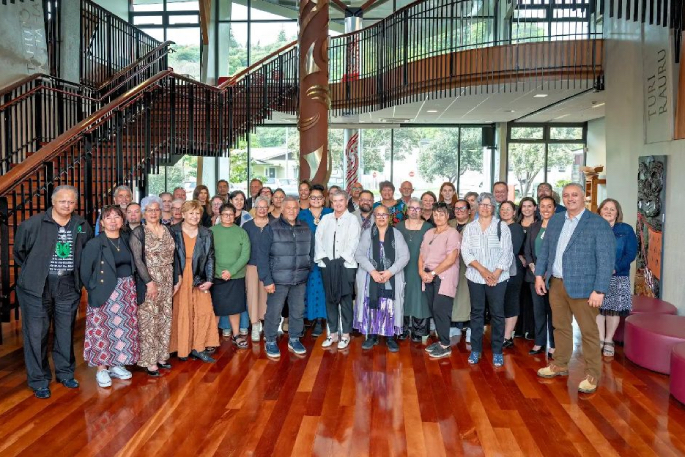A third of the Iwi Māori Partnership Boards including five from the Te Manawa Taki region have united in Whakatāne to present their Community Health Plans to government officials, fulfilling their legislated function on behalf of Iwi, hapū, and whānau.
As part of the reset of Te Whatu Ora Health New Zealand, newly appointed deputy CE and regional director Catherine Cronin received the Community Health Plans and Hauora Māori Priority Reports highlighting Whānau Voices.
This information was gathered from whānau, hapū and hapori to shape individual IMPB priorities and consolidated into regional priorities to tackle the ‘grim picture’[1] of the state of Māori health. This is a reference to pages 53 and 54 in the Waitangi Tribunal Hauora Report 2019 where it highlightst that the gap in life expectancy at birth between Māori and non-Māori is 7.3 years for males and 6.8 years for females.
“The purpose of our collective is to mahi tahi - to work together- to achieve the health and wellness aspirations of our whānau,” said Te Tiratū IMPB co-chair Kataraina Hodge.
Collectively, the six boards serve a combined Māori population of 285,560.
“Our role is not only integral, but fundamental to the success of Te Whatu Ora Health New Zealand and the system’s responsiveness to Māori health needs,” said Tūwharetoa IMPB chair Louisa Wall.
The IMPB are responsible for assessing, monitoring, planning and represent local Māori perspectives on the design and delivery of services and public health interventions within localities.
Their shared priorities focus on public and population health, primary and community care, hospital and specialist services and priorities, workforce, data and funding appropriation for a redesigned delivery model.
“We are all experiencing the same levels of high health need for our whānau so the strategic emphasis into the prevention and health promotion space is essential to make meaningful progress,” Hodge said.
Each IMPB collected the voices of whānau through workshops and surveys, blending these insights with data from Te Whatu Ora and Primary Health Organisations to develop comprehensive, evidenced-based reports for each rohe.
This effort upholds the IMPB’s statutory responsibility in their relevant localities.
The Boards have aligned around regional strategies and delivered all key documents within Minister Reti’s expected timelines—most significantly, meeting the September 30 deadline to be ready for co-commissioning opportunities from January 1 2025.
“Today is another important milestone in achieving our moemoeā (vision) for our whānau. We are actively participating in shaping regional health priorities that we expect will influence funding based on need ahead of the 2025 Budget,” said Te Taura Ora o Waiariki IMPB co-chair Aroha Morgan.
One critical task ahead is addressing the status of legacy contracts for Māori Providers - to maintain continuity and capacity in the system - which have been extended until June 30 next year.
"We strongly advocate for evergreen contracts for our providers, given the urgent state of our health needs. At every opportunity, we’ve made it clear to politicians and officials: contracts for Māori health providers must be extended and prioritised,” said Te Moana a Toi IMPB co-chair Rutu Maxwell-Swinton.
The hui was hosted at Te Whare Wānanga o Awanuiārangi, a Ngāti Awa-founded tertiary provider known for its essential role in training and developing the Hauora Māori workforce. The Boards expressed deep appreciation to the Wānanga for providing the venue for this important briefing.
“Since our establishment, we've been following our statutory responsibilities to ensure that we have robust governance structures and operational capability,” one Board member explained.
“We've had to set up charitable trusts and ensure that trustees represent iwi and mātāwaka organisations from each rohe, which is no small task.”
The IMPBs have collaborated with Te Whatu Ora and Manatū Hauora navigating changes in legislation, leadership, and planning approaches during the transition to a new coalition government.
“We’ve seen a shift from Locality Plans to Community Health Plans. It wasn’t until July this year that we had clarity on the new Minister’s expectations—before that, we were operating under Labour’s directives,” said Te Moana a Toi IMPB incoming co-chair Hone Te Rire.
The independent analysis aligns with key government priorities, reflecting a shared commitment to achieving mutual goals.
“It’s a great day for us but it’s got to be taken seriously, I was here 35 years ago and not a lot has changed in Māori health,” said Te Punangaora IMPB chair Te Pahunga Davis.
“I live in hope that we can make a difference that we can measure. With that I support our pukapuka being placed into the kete but we’ll be watching you, or we aren’t doing our job.”
The rōpū has heard “loud and clear” the consistent message from whānau about Hauora Māori that mirrors what’s been happening over the last 40 years societally that has led to more highly, complex comorbidities.
“Nothing's really changed. Now we’re living in a climate of household stress, whether that be income, unhealthy homes, violence, lack of job security - all those determinants of health have doubled down on our people over this last decade especially,” said Davis.
Beyond forming the Iwi Māori Partnership Boards and underpinning flax-roots efforts, there is a shared belief that true solutions lie in our vibrant young Māori demographic, now 978,246 strong according to the 2023 Census.
“Our emerging next generation bring an inspiring energy and a sense of hopefulness for the future. For us ultimately that's going to play a pivotal part in the shift for addressing health inequities.”



0 comments
Leave a Comment
You must be logged in to make a comment.